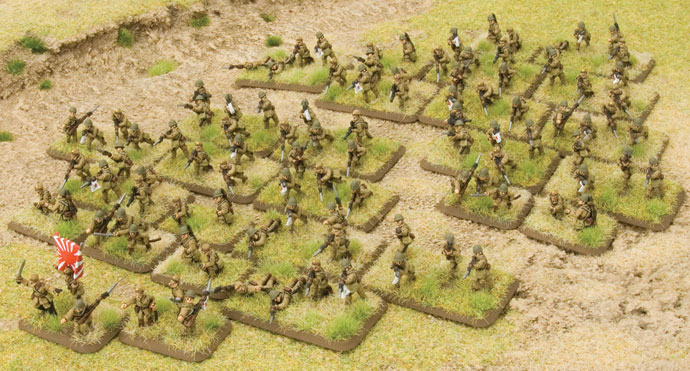Though Japanese tanks would rapidly fall far behind the rest
of the world in terms of both technology and quantity, as late as 1940 Japan
fielded the fifth largest armored force in the world! Given that fact, and with
the the upcoming release of Banzai,
many players are looking into how they should paint their Japanese armor. I
contributed to the original Japanese armor painting guide in Rising Sun book, but given Banzai covers a wider time period and
range of vehicles, I decided to update my painting guide based on what is
available today. Another consideration is that often the available information
on Japanese World War II tank camouflage is contradictory, so this represents
my current best representation based on available information. If I have any
readers in Japan, I’d love to correspond with you on this topic!
Pre-1942, the Japanese used a variety of camouflage
schemes and colors – the most common being a hard-edged three-tone scheme. In
some occasions the transitions between the camouflage colors were traced with
black or dark gray lining. Disruptive stripes of yellow were also used on some
vehicles – note, the disruptive yellow stripe could be coupled with the black
or dark gray lining between colors, especially on Type 89 medium tanks. The
three primary colors were khaki (Khaki-iro) – also known as “Japanese Artillery
Brown” with disruptive patterns of roughly 30% mahogany brown (Tochi-iro) and
an olive green (Midori-iro). In some cases a fourth darker khaki color is evident - referred to as an "Alternate" to the basic Khaki in the chart below.
Starting in 1942, the Japanese transitioned to a new set
of colors in an effort to better standardize its camouflage schemes. The
black/dark gray lining and the disruptive yellow stripes were officially
dropped. A new three color camouflage scheme was adopted using a new khaki
color similar to German Panzer Dark yellow – in some references called “Parched
Grass” (Karekusa-iro). The disruptive colors were a dark olive green or drab (likely Tsutikusa-iro) and a dark mahogany brown (also
called Tochi-iro in many references, though in some cases the shade identified is darker than
the pre-1942 version). In the South Pacific, an additional Willow Green color (Kusa-iro) was specified rather than the darker olive color.
Some tank components, such as guns, also appeared to have retained the
legacy “Atrillery Brown” (Khaki-iro) color, though other references have this as a slight variant of the base khaki. Camouflage schemes were generally
hard edged, but beginning in 1943 feathered edged camouflage patterns became
increasingly evident.
The chart above shows my current best data for the various colors used by the Japanese on their AFV's both before and after standardization in 1942. The Gunze Mr. Colors are taken directly from their commercially available paint sets for early and late war tanks. The Tamiya color equivalents are taken from various recent 1/35th scale kits and represent a major update to older instruction sets. The Ammo of MIG colors for early war come from their WWII Japanese early colors "Smart Set," while the late war colors represent a mix of color matching by eye and converting RAL colors (from Tamiya and Gunze) to their Ammo of MIG equivalent. The Vallejo colors were obtained using color charts and eye matching, while most of the new Battlefront colors come from their painting Japanese page with updates based on the late war examples done by eye based on the current range. I haven't seen the modeling page in Banzai, so Battlefront may have other suggestions. Vallejo Air also has an IJA range which I've added to the table above (with the addition of an olive drab from the same range).
When painting your force, it is important to consider that Japanese tanks were often not re-painted in the field. It is therefore completely acceptable to have a mix of early and late war paint schemes in the same force. The post-1942 schemes should therefore be far more prevalent on vehicles produced starting in 1942 such as the Type 97 Kai (Shinhoto Chi-ha), some Type 95 tanks, any tanks reserved for defense of the home islands, and the various self-propelled guns based on the Chi-ha. Hopefully you will find this chart helpful. I plan to continually update it as additional data (and hopefully new paints!) become available in the market.




